How do you go from being a relatively inexperienced ultrarunner to completing an extremely challenging multiday, self-supported stage race, with less than a year to train?
I spent the past ten months coaching two of my clients to make that journey. Jacob Kaplan-Moss of Davis finished the 170-mile Grand to Grand Ultra in Utah a couple of weeks ago, and Kim Bueno of Austin finished the 155-mile Atacama Challenge in Chile last week. Both finished near the top third of the field.
I’m sharing the outline of their training plan, and their stories of what the events were like, to show how to safely increase mileage and meet the myriad challenges of an ultra-long stage race. And, perhaps, to inspire your new year’s goals.
(For more info on what stage races are all about, check out this article I wrote for Trail Runner, “5 Ways to Know if a Stage Race is For You.” For more detailed training advice, please buy my book The Trail Runner’s Companion,as it goes in depth about the mental and physical prep needed to achieve this type of ultra-distance challenge.)
Part 1: Improve fitness and consistency for the marathon-to-50K distance.
Both Jacob and Kim started working with me in mid-January with new year’s goals of completing these big stage races in the fall. Jacob, a software developer, had done a few 50Ks, had barely finished one 50-miler and had DNF’ed a 100K. Kim, a trial attorney who frequently has to travel for litigation, had run a bunch of marathons and a few 50Ks, but nothing longer.
“Early in the year, I was intimidated by the idea of back-to-back-to-back long runs,” recalls Kim. “I knew I could do a few days, but I was concerned about my ability to handle a full week. Another big obstacle in my mind was gear. How could I carry everything I needed for a week on my back? The idea of a stage race was foreign to me, so I had lots of questions about the training and logistics.”
Jacob recalls, “170 miles in a week [for the Grand to Grand Ultra] sounded nearly impossible, considering that my biggest week of running previously was about 55 miles. Specifically the [52-mile] long stage had me very worried. Before this year, I’d only done two races over 50k, and neither went well … and both of those races I was rested and tapered! So the prospect of tackling a 50+ mile day with nearly 60 miles already on my legs was daunting.”
I told them to put their worries aside, hold off on planning for the stage race, and concentrate first and foremost on becoming better runners—meaning, more efficient, faster and stronger at the distances they already can handle.
Our first priority was to get on a consistent routine of running that included speedwork, hill work, long runs, and some time-efficient conditioning with an emphasis on core strength, balance and physical therapy for injury prevention. Since they both work demanding jobs, maintaining a consistent routine was no easy feat. They both ended last year with erratic weekly mileage averaging in the mid 20s to mid 30s; from January to March, we made each of their workouts purposeful and gradually increased their weekly volume to the mid to high 40s.
“The biggest challenge for me was finding time to train with a busy work schedule,” says Kim. “I decided early on that running was a priority for the year. Instead of trying to squeeze in runs between work commitments, I decided to build my work schedule around my runs. With this mindset, I gave myself permission to take more time for workouts than I had in the past. Initially, I believed this would cause me to be less productive at work, but that was not the case. The training program gave me extra energy that enabled me to have a productive work year as well.”
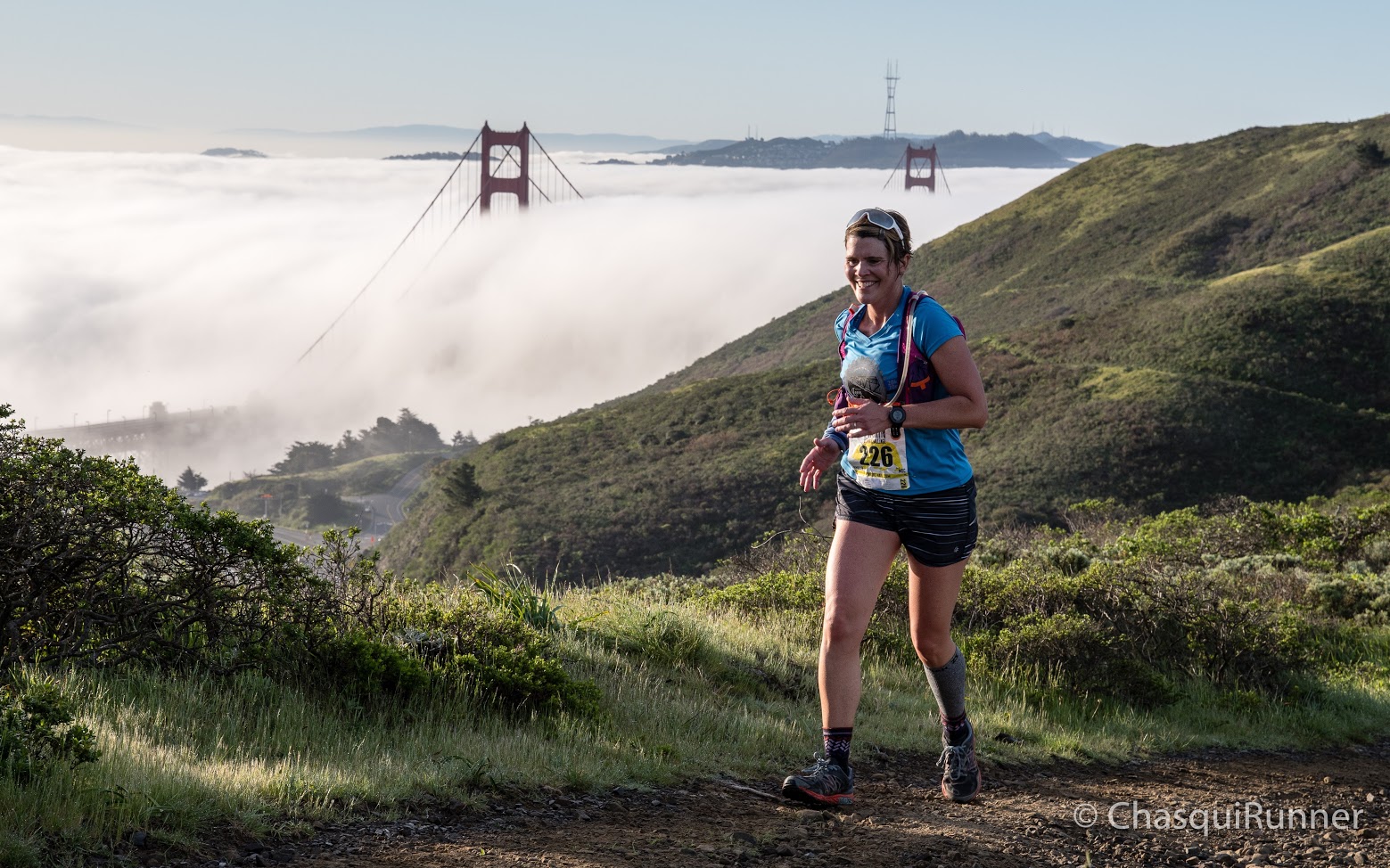
Kim running the Marin Ultra Challenge 50K last March. Photo by Chasqui Runner
Meanwhile, each trained for some spring races that motivated them to develop their speed as well as endurance, and that allowed them to practice race-day execution.
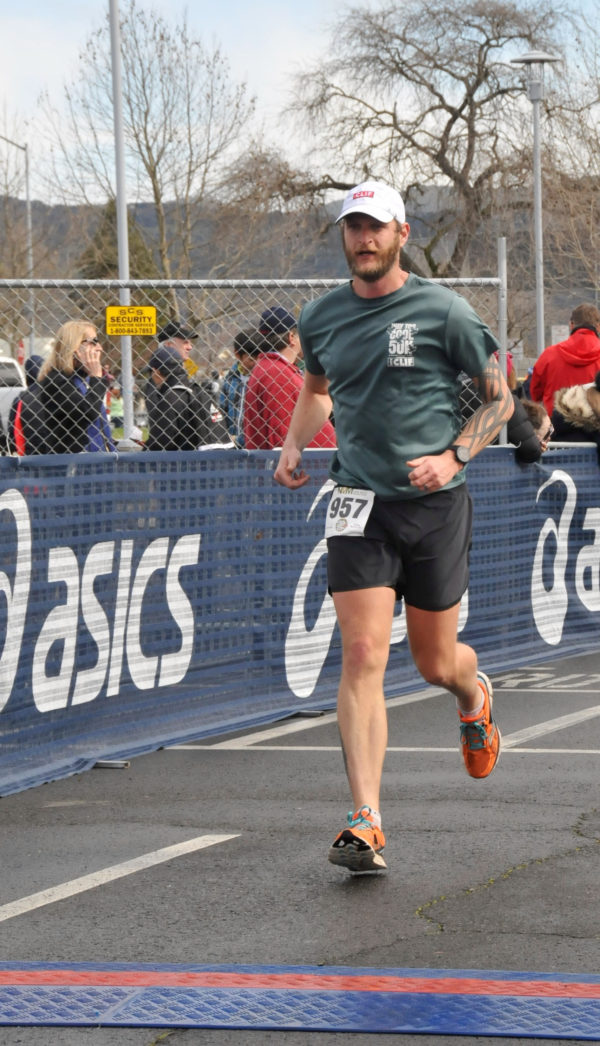
Jacob finishing the Napa Valley Marathon last March.
Jacob trained for and PR’ed at the Napa Valley Marathon in 3:50 in early March, and then also PR’ed at the Mendocino 50K in April with a time of 6:00. Kim ran a trail marathon in February and the Marin Ultra Challenge 50K in March, finishing strong in 6:42–not quite a PR, but she was coping with a calf strain caused by a fall on the trail and therefore ran conservatively.
“I started the year basically not doing speedwork seriously, and definitely not in any sort of structured way, and mostly hating it,” says Jacob. “I can’t pinpoint exactly when it changed, but by mid-summer I’d started to love it, and was looking forward to my speedwork sessions as much as my long runs. This is clearly a place where coaching really helped me: the consistency, structure and accountability got me to stick with it long enough to learn to like it and see good results.”
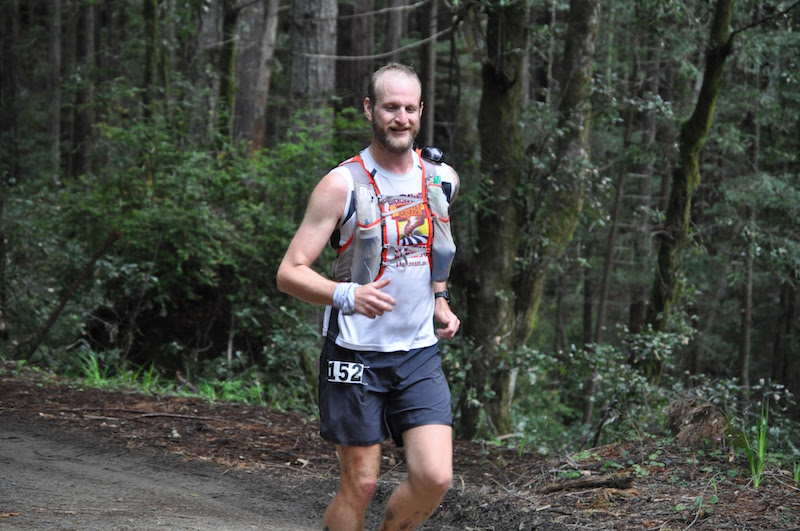
Jacob running the Mendocino 50K.
Part 2: Develop as an ultrarunner and nail a tough, long race.
Heading into summer, both set their sights on training for and succeeding at a challenging 50-miler. For Kim, that meant the Bryce 50 in June; for Jacob, the Tahoe Rim Trail 50 in July.
Self-supported stage races like the Grand to Grand Ultra or the 4Deserts Series (which includes the Atacama race) typically feature a 50-miler as “the long stage,” which participants must complete on very tired legs since they’ve been running high mileage earlier in the week, plus they’re carrying their food and gear for the week in a pack. Therefore, it was important that both Kim and Jacob felt confident in their ability to complete a 50-miler under challenging circumstances that included tough terrain, heat and high altitude to mimic their stage races.
Once they recovered from their springtime 50Ks, we focused very specifically on training for these tough 50s, which meant more heat training (not a problem since they both live in places where temperatures regularly hit the 90s to 100s); running late in the day to mimic late-day fatigue; and completing long runs on steep, rugged terrain. Jacob, who lives in pancake-flat Davis, incorporated plyometrics to substitute for hill training and made an effort to drive to mountainous destinations, like Mount Diablo and the Sierra foothills, for training on the weekends.
Both got their weekly mileage up to the 50s, so 50 miles/week felt like a manageable “new norm,” and some weeks hit the 60s in mileage with a few carefully planned back-to-back long runs. The result? Kim finished her first 50-miler under extremely challenging conditions, in 14:03; she paused midway to help her husband, who also was running it and became ill, and she persisted on a day when numerous runners DNF’ed and needed medical assistance for heat stress and dehydration. Jacob finished the TRT50 in 13:45 in spite of heat and nausea. They both succeeded in getting through rough patches to finish.
Through spring and summer, we also worked on mental training. Recalls Jacob, “Several times you told me that if I felt crummy during a long run to remind myself that it was training for when I felt bad during a race. This really worked for me; it got me through several pretty bad runs. Indeed, at the TRT 50 when I got nauseous at mile 35 like I often do, instead of getting angry about it, I was able to say to myself, ‘Hey, this is practice for the long stage; you get to try a few things and see what works.’ And then when I indeed did get nauseous during the long stage [during the Grand to Grand Ultra], I felt like I’d prepared and practiced for it, and I knew I could get through it.”
Part 3: Prepare for and practice the unique challenges of a multiday, self-supported stage race.
Once Kim and Jacob recovered from their 50-mile races, I modified their weekly routines to incorporate all the things they needed to practice for the stage races: running with a pack full of 15 to 20 pounds of food and gear, running through sand, running at night, running more back-to-back long runs, fine-tuning their mid-run hydration and nutrition to mimic what they’d have available during the stage race, and experimenting with race-specific gear such as trekking poles and sand gaiters. They each had about 12 weeks for this focused, intense summer training that incorporated unique stage-racing elements, which was sufficient.
The point is, if you’re training for a self-supported stage race, I recommend working on your fitness, endurance and general ultrarunning and hiking skills first, then introduce pack training, back-to-backs and other stage-race elements approximately three months prior to the big stage race. If you start training with a weighted pack and focus exclusively on your stage-race prep too early in your training cycle, then you may risk injury or burnout and also may shortchange your fitness.
“You helped me figure out what I needed to worry about and when; for example, you told me early in the year not to worry about gear until the summer,” says Kim. “That advice allowed me to concentrate on my spring training without the extra burden of obsessing about my clothing, sleeping bag and food [for the stage race]. I also liked the progression of training leading up to my first 50-miler, and then backing down again before the summer push.”
Both Jacob and Kim had peak long back-to-back-to-backs four to five weeks before their stage race. Kim ran and hiked three 20-milers in a row on tough trail terrain, using all her stage-racing gear, over Labor Day Weekend. Jacob took all of his gear and additional camping supplies to do a three-day run/hike adventure around Yosemite National Park, each day completing mileage in the high teens to 20s.
“The peak weeks leading up to TRT50 and G2G [Grand to Grand] were intense, right there at the limit of what I could handle,” recalls Jacob. “It felt good to be pushing myself that much, but it was hard. This is another point where coaching really helped, because I don’t think I could have pushed myself that hard on my own.”
Jacob’s final long “run” was actually mostly hiking with me as a pacer for 30 miles when I did the Run Rabbit Run 100 in early September. He accompanied me from sunset past midnight, when I lost my ability to run more than short spurts and was reduced to hiking due to fatigue and soreness. He also witnessed my downward mood spiral (see race report). “Watching you struggle was a really useful experience for me,” he told me with an apologetic laugh. “You are a more accomplished runner than I am, and I tend to assume that people who are better, are better because they struggle less.”
Nope, we all struggle, especially when pushing our limits!
So, how’d they do?
Neither Jacob nor Kim had an ideal race at Grand to Grand and Atacama; troubles cropped up, but that’s the nature of an extra-long ultra or stage race, so they knew to “expect the unexpected.” Ironically, those low points made the overall experience more rewarding in some ways, they say.
Jacob’s first two stages (31 and 27 miles) went well, and he ran or hiked steadily and finished strong in the top third of the field. Then, near sunset on the 52-mile Stage 3 (the long stage), when he faced miles of relentless steep sand dunes, cross-country bushwhacking and then more miles of sandy track, the suffering began.
“I’d been struggling with nausea for a few hours” starting around Mile 30, “and I was several hours behind the pace I’d hoped to set. I was vomiting, starting to get dehydrated and struggling to walk through what should have been a fairly runnable stretch. I knew I still had the dunes to get through and was feeling demoralized. I ended up spending nearly an hour at Check Point 6 [at nighttime, following the dunes], sitting at the fire and trying to get some food and water down. I finally managed to eat some soup, felt a bit better, and left with a group to tackle the rest of the night. The rest of the evening wasn’t great, but it got a bit better….
“Part of what got me through was just experience,” he continues. “I’d felt this way before, knew I could manage it, and didn’t let the physical discomfort translate into too much mental suffering. The other part was just a real determination not to DNF; I just didn’t let it be an option. My attitude was that as long as I could keep moving forward, I would. The only way I wasn’t going to finish was to miss a cutoff or get pulled by the medical staff.”
Jacob finished the long stage in just over 22 hours. “I was so spent I didn’t feel anything. I was completely emotionally drained,” after the long stage, he recalls. “You said to expect the long stage to feel like a 100-miler, but I didn’t know what that would feel like.”
Jacob still had to run three more stages, a total of about 60 miles.
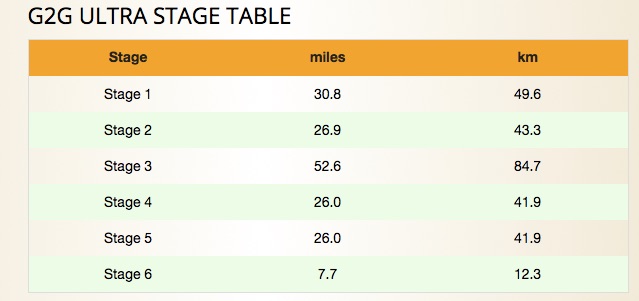
The Grand to Grand Ultra mileage breakdown.
“I’ll always remember Stage 4, the day after the long stage,” he says. “I woke up that morning feeling terrible: my left ankle hurt, and so did my right knee. I felt like I could barely walk. I started off that morning at a very slow hike, just feeling really sorry for myself. I got to the first checkpoint with only about 30 minutes to spare, not having run a step. And then, slowly, over the next couple of hours, things started to get better. Not quickly, and not all at once, but bit by bit I felt better. I ran a little, then a little more, hiked faster, and slowly it just came back! By the end of the day, I was running hard—as well as I did all week—and feeling fast and strong again. I finished the stage on one hell of an adrenaline high. That feeling of pulling myself up out of my pity party and finding I could run again—and run well—was amazing. I’ll never forget it.”
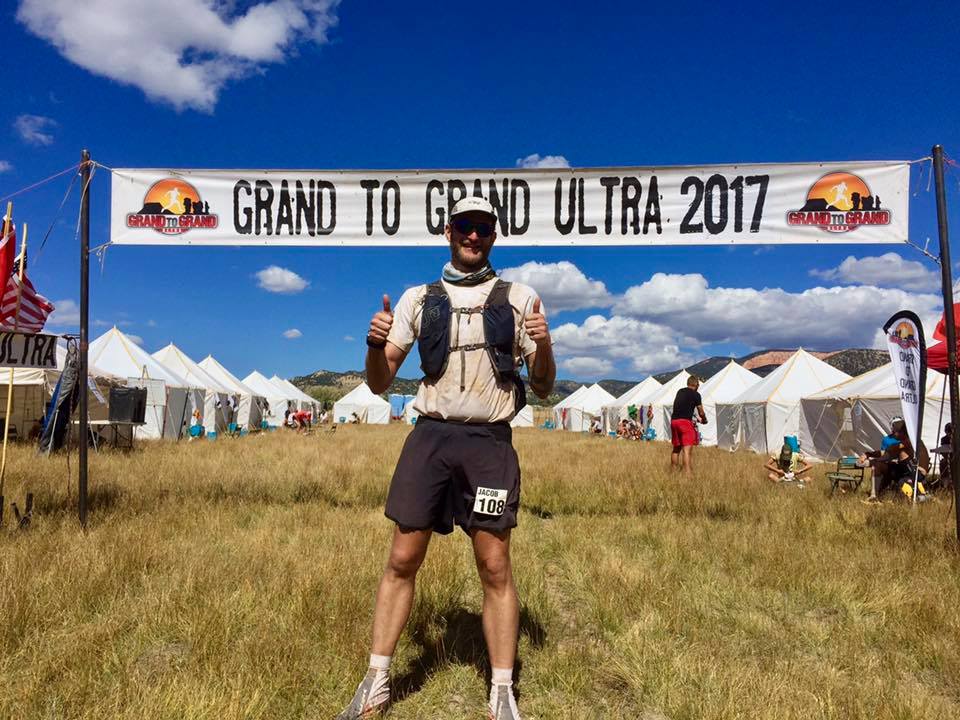
Jacob finishing Stage 5. Photo courtesy Grand to Grand Ultra
Jacob finished the 170 miles with a cumulative time of 52 hours, 15 minutes, 37th overall in a field that had 92 finishers and 26 DNFs.
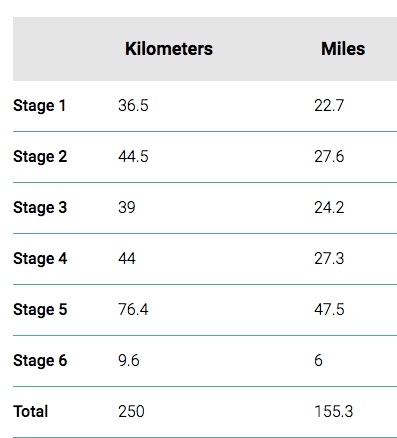
The Atacama Crossing mileage breakdown.
Kim ran into trouble on the second day, when she tripped on a rock and aggravated a nagging soreness in her glute/hamstring area. “The pain was sharp and frightening. I tried to run through it, but I was unable to do so,” she recounts. “Luckily, hiking was manageable, so I hiked the rest of the stage as I reevaluated my plan. As part of the coaching program, you encouraged me to think about various scenarios before the race. One of the scenarios I considered was how I would deal with an unexpected injury. I had already decided that I would finish in any way I could, even if it required hiking the entire week. Although I must admit I had a bit of a pity party for myself when I got hurt, it was short-lived. I had already decided to continue to the finish, so I didn’t have a decision to make. I just executed ‘Plan B.’ I may not have been fast, but I sure did enjoy the week. I am also convinced that coaching program gave me the stamina and endurance to survive even more hours on my feet than I had anticipated!”
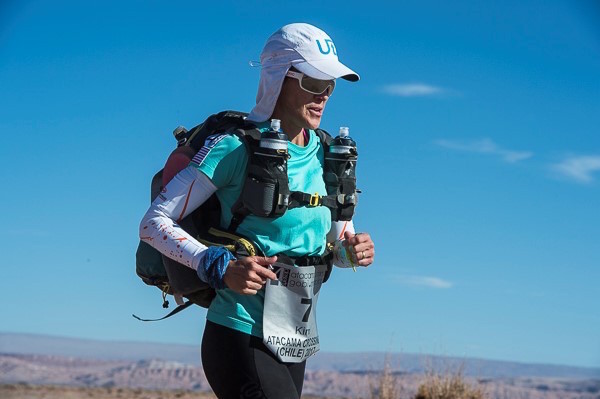
Kim in Stage 3 of the Atacama Crossing.
Kim finished the 155 miles with a total time of 48 hours, 9 minutes, 38th overall (15th female) out of a field that had 85 finishers and 13 DNFs.
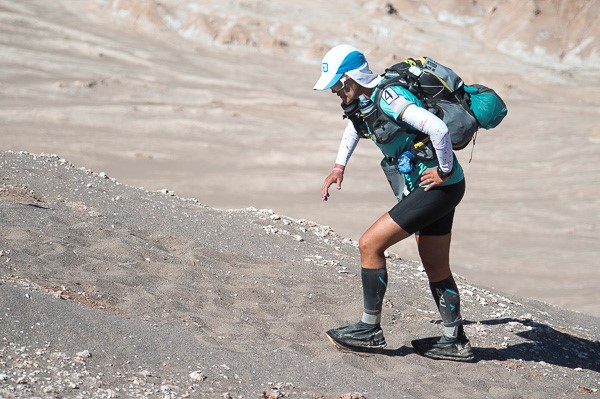
Kim hiking through Stage 5.
“I’ve learned so many valuable lessons over this year—both about running and about myself,” says Kim. “I appreciated how you encouraged me to try different things on training runs to determine what worked best for my body. Your coaching also taught me the importance of rest and recovery. I didn’t prioritize those things in the past, and I’ve noticed significant improvement in my fitness as I’ve implemented true rest days. I’ve also learned to be patient and think about long-term goals. Although the Atacama Crossing was my immediate goal for this training cycle, I also want to run for many years to come. Your scheduled encouraged me to do more stretching, foam rolling and conditioning than I would have done otherwise. I believe this program helped me get through the training without any significant injuries or long-term setbacks.”
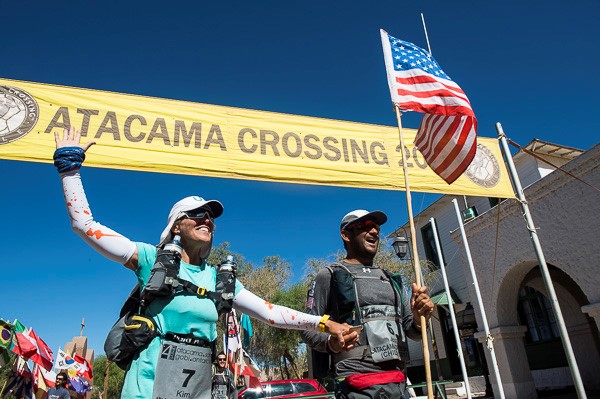
Kim finishing Atacama with her husband Jerry.
“My husband Jerry also did the Atacama Crossing this year,” Kim adds. “We decided before the start that we would each run our own race, rather than try to run the entire week together. When I got hurt on the second day, I encouraged Jerry to continue running. He was feeling good and could have continued at a faster pace. Instead, he stayed by my side and hiked with me the rest of the week. Best of all, he wore a constant smile and had a wonderful attitude throughout the week. I am very grateful to him for lifting my spirits and encouraging me to enjoy the journey, despite a bit of pain.”
Last week, Jacob told me, “I do miss it [the Grand to Grand Ultra] already—it was a really special experience, and everything I wanted it to be and a lot more. For as bad as some of the parts were, the good parts wouldn’t have been as good if I didn’t have to go through the bad. The feeling of being able to get through those low spots and diagnose and pull out of it was really great.”
So there you have it—two examples of runners who set big goals for the new year and fulfilled them.
If you want more info on stage racing training, I have a category of archived posts about it here. For more info on my coaching, please see my site (I’m presently full of clients but will have spots open in the coming year); and, my coaching advice is distilled in The Trail Runner’s Companion: A Step-by-Step Guide to Trail Running and Racing, from 5Ks to Ultras.
Congrats to Jacob & Kim!

Finding time to train with a busy work schedule does take a lot of determination and discipline! Good on ya!